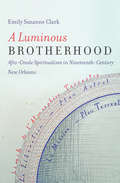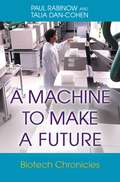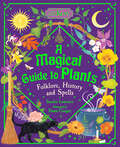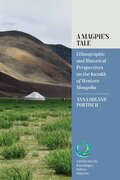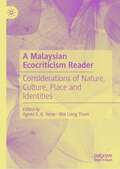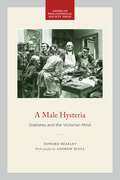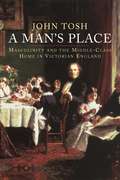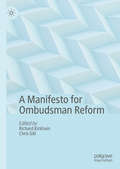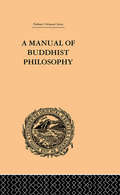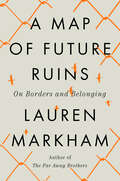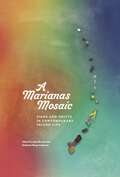- Table View
- List View
A Love for Nothingness, A Love for Death: The Metaphysics of Desire
by Alberto CastelliThis book aims at explaining romantic love between straight adults through literary texts of the western canon from the nineteenth and twentieth century. Each chapter comes with a multidisciplinary approach in which protagonists are mutilated in their quest for loving as alternative to annihilation. The book emphasizes love as an obsession, thus as an exploration of the mind. From the passion-myth of Tristan and Isolde to the nihilist modernist representations, the western world has created a perverse concept of love. A love for nothingness, for death. Narcissistic and at times destructive, love is gained by overcoming obstacles. If without obstacles there is no love, then love becomes love for obstacles. Within this masochistic frame, love, falling in love, being loved always stand at the edge of pathology. At its core this book narrates a love story, more precisely a story of loves, the haunting evocation of a desire that by its very nature cannot be fulfilled. Inherent in the nature of love is a subtle dialectical activity between presence and absence, between creation and destruction, reality and void. Accordingly, the narrative raises questions that the past two centuries were incapable of answering. Does love only last the time of a kiss? Is its promise fatally destined to dissolve? What about violence? Physical, emotional, temporal. Is it an ineliminable part of love or its most extreme profanation? And what is the mystery that accompanies loves that know how to last without resigning themselves to the death of desire? It is to answer some of these questions that I wrote this text. Love is an unconscious process that dominates reason and destroys it when reason cannot be a mode of communication. Hence, the amorous romance is madness and this text is written as a loud reminder.
A Lucky Life Interrupted
by Tom BrokawFrom Tom Brokaw, the bestselling author of The Greatest Generation, comes a powerful memoir of a year of dramatic change--a year spent battling cancer and reflecting on a long, happy, and lucky life. Tom Brokaw has led a fortunate life, with a strong marriage and family, many friends, and a brilliant journalism career culminating in his twenty-two years as anchor of the NBC Nightly News and as bestselling author. But in the summer of 2013, when back pain led him to the doctors at the Mayo Clinic, his run of good luck was interrupted. He received shocking news: He had multiple myeloma, a treatable but incurable blood cancer. Friends had always referred to Brokaw's "lucky star," but as he writes in this inspiring memoir, "Turns out that star has a dimmer switch." Brokaw takes us through all the seasons and stages of this surprising year, the emotions, discoveries, setbacks, and struggles--times of denial, acceptance, turning points, and courage. After his diagnosis, Brokaw began to keep a journal, approaching this new stage of his life in a familiar role: as a journalist, determined to learn as much as he could about his condition, to report the story, and help others facing similar battles. That journal became the basis of this wonderfully written memoir, the story of a man coming to terms with his own mortality, contemplating what means the most to him now, and reflecting on what has meant the most to him throughout his life. Brokaw also pauses to look back on some of the important moments in his career: memories of Nelson Mandela, the Dalai Lama, the fall of the Berlin Wall, the morning of September 11, 2001, in New York City, and more. Through it all, Brokaw writes in the warm, intimate, natural voice of one of America's most beloved journalists, giving us Brokaw on Brokaw, and bringing us with him as he navigates pain, procedures, drug regimens, and physical rehabilitation. Brokaw also writes about the importance of patients taking an active role in their own treatment, and of the vital role of caretakers and coordinated care. Generous, informative, and deeply human, A Lucky Life Interrupted offers a message of understanding and empowerment, resolve and reality, hope for the future and gratitude for a well-lived life.From the Hardcover edition.
A Luminous Brotherhood: Afro-Creole Spiritualism in Nineteenth-Century New Orleans
by Emily Suzanne ClarkIn the midst of a nineteenth-century boom in spiritual experimentation, the Cercle Harmonique, a remarkable group of African-descended men, practiced Spiritualism in heavily Catholic New Orleans from just before the Civil War to the end of Reconstruction. In this first comprehensive history of the Cercle, Emily Suzanne Clark illuminates how highly diverse religious practices wind in significant ways through American life, culture, and history. Clark shows that the beliefs and practices of Spiritualism helped Afro-Creoles mediate the political and social changes in New Orleans, as free blacks suffered increasingly restrictive laws and then met with violent resistance to suffrage and racial equality. Drawing on fascinating records of actual seance practices, the lives of the mediums, and larger citywide and national contexts, Clark reveals how the messages that the Cercle received from the spirit world offered its members rich religious experiences as well as a forum for political activism inspired by republican ideals. Messages from departed souls including Francois Rabelais, Abraham Lincoln, John Brown, Robert E. Lee, Emanuel Swedenborg, and even Confucius discussed government structures, the moral progress of humanity, and equality. The Afro-Creole Spiritualists were encouraged to continue struggling for justice in a new world where "bright" spirits would replace raced bodies.
A Lynching at Port Jervis: Race and Reckoning in the Gilded Age
by Philip DrayAn account of a lynching that took place in New York in 1892, forcing the North to reckon with its own racism.On June 2, 1892, in the small, idyllic village of Port Jervis, New York, a young Black man named Robert Lewis was lynched by a violent mob. The twenty-eight-year-old victim had been accused of sexually assaulting Lena McMahon, the daughter of one of the town's well-liked Irish American families. The incident was infamous at once, for it was seen as a portent that lynching, a Southern scourge, surging uncontrollably below the Mason-Dixon Line, was about to extend its tendrils northward. What factors prompted such a spasm of racial violence in a relatively prosperous, industrious upstate New York town, attracting the scrutiny of the Black journalist Ida B. Wells, just then beginning her courageous anti-lynching crusade? What meaning did the country assign to it? And what did the incident portend?Today, it’s a terrible truth that the assault on the lives of Black Americans is neither a regional nor a temporary feature, but a national crisis. There are regular reports of a Black person killed by police, and Jim Crow has found new purpose in describing the harsh conditions of life for the formerly incarcerated, as well as in large-scale efforts to make voting inaccessible to Black people and other minority citizens. The “mobocratic spirit” that drove the 2021 attack on the U.S. Capitol—a phrase Abraham Lincoln used as early as 1838 to describe vigilantism’s corrosive effect on America—frightfully insinuates that mob violence is a viable means of effecting political change. These issues remain as deserving of our concern now as they did a hundred and thirty years ago, when America turned its gaze to Port Jervis.An alleged crime, a lynching, a misbegotten attempt at an official inquiry, and a past unresolved. In A Lynching at Port Jervis, the acclaimed historian Philip Dray revisits this time and place to consider its significance in our communal history and to show how justice cannot be achieved without an honest reckoning.
A Machine That Would Go of Itself: The Constitution in American Culture
by Russell FraserIn this volume, Pulitzer Prize-winning historian Michael Kammen explores the U.S. Constitution's place in the public consciousness and its role as a symbol in American life, from ratification in 1788 to our own time. As he examines what the Constitution has meant to the American people (perceptions and misperceptions, uses and abuses, knowledge and ignorance), Kammen shows that although there are recurrent declarations of reverence most of us neither know nor fully understand our Constitution. How did this gap between ideal and reality come about? To explain it, Kammen examines the complex and contradictory feelings about the Constitution that emerged during its preparation and that have been with us ever since. He begins with our confusion as to the kind of Union we created, especially with regard to how much sovereignty the states actually surrendered to the central government. This confusion is the source of the constitutional crisis that led to the Civil War and its aftermath. Kammen also describes and analyzes changing perceptions of the differences and similarities between the British and American constitutions; turn-of-the-century debates about states' rights versus national authority; and disagreements about how easy or difficult it ought to be to amend the Constitution. Moving into the twentieth century, he notes the development of a "cult of the Constitution" following World War I, and the conflict over policy issues that persisted despite a shared commitment to the Constitution.
A Machine to Make a Future: Biotech Chronicles
by Paul Rabinow Talia Dan-CohenA Machine to Make a Future represents a remarkably original look at the present and possible future of biotechnology research in the wake of the mapping of the human genome. The central tenet of Celera Diagnostics--the California biotech company whose formative work during 2003 is the focus of the book--is that the emergent knowledge about the genome, with its profound implications for human health, can now be turned into a powerful diagnostic apparatus--one that will yield breakthrough diagnostic and therapeutic products (and, potentially, profit). Celera's efforts--assuming they succeed--may fundamentally reshape the fabric of how health and health care are understood, practiced, and managed. Presenting a series of interviews with all of the key players in Celera Diagnostics, Paul Rabinow and Talia Dan-Cohen open a fascinating window on the complexity of corporate scientific innovation. This marks a radical departure from other books on the biotech industry by chronicling the vicissitudes of a project during a finite time period, in the words of the actors themselves. Ultimately, the authors conclude, Celera Diagnostics is engaged in a future characterized not by geniuses and their celebrated discoveries but by a largely anonymous and widely distributed profusion of data and results--a "machine to make a future." In their new afterword, Rabinow and Dan-Cohen revisit Celera Diagnostics as its mighty machine grinds along, wondering, along with the scientists, "what constitutes success and what constitutes failure?" The pathos of the situation turns on how one poses the question as much as how one answers it.
A Magical Guide to Plants: Folklore, History and Spells
by Sandra LawrenceMadame Volare, apothecarist and witch extraordinaire invites you to be her apprentice and learn about the world's most magical plants.For thousands of years, plants have been used to heal and soothe. Discover the amazing power within a humble leaf, seed, petal and stem, and how our ancestors feared or revered flowers and herbs. From the mandrake that bestows luck to the calming St John's wort, take a fascinating walk through a witch's garden, exploring the uses, folklore and history of over fifty common plants.Respect and marvel at the pure magic of the natural world and how you can harness its power for your own health and happiness.
A Magpie’s Tale: Ethnographic and Historical Perspectives on the Kazakh of Western Mongolia (Lifeworlds: Knowledges, Politics, Histories #1)
by Anna Odland PortischTelling the story of the author's time living with a Kazakh family in a small village in western Mongolia, this book contextualizes the family’s personal stories within the broader history of the region. It looks at the position of the Kazakh over time in relation to Tsarist Russian, Soviet, Chinese and Mongolian rule and influence. These are stories of migration across generations, bride kidnappings and marriage, domestic violence and alcoholism, adoption and family, and how people have coped in the face of political and economic crisis, poverty and loss, and, perhaps most enduringly, how love and family persist through all of this.
A Malaysian Ecocriticism Reader: Considerations of Nature, Culture, Place and Identities
by Agnes S. K. Yeow Wai Liang ThamThis collection of essays brings together ecocritical interpretations of Malaysian texts – including fiction, nonfiction, and other media / cultural expressions. It includes original works by environmental activists as well as emerging and established scholars, who collectively analyse various aspects of Malaysian ecological discourse.The contributors address crucial – and often controversial – topics such as local ecological imaginations, wildlife conservation, overdevelopment, postcolonial ecological identities, biopolitics, nature and sexuality, nature and race, the commodification of nature, nature–culture embodiments and entanglements, human–animal relations, waste and materiality, human and other-than-human agency, toxicity and slow violence, self-representations as well as attitudes towards land, nativity and indigeneity, migrancy and diaspora.Readers will gain valuable insights into the ways in which environments and ecological relationships are mediated within this national space, while opening up room to theorise beyond its boundaries.
A Male Hysteria: Diabetes and the Victorian Mind
by Edward BeasleyA history of diabetes science and the experience of diabetics in the nineteenth-century EnglandA Male Hysteria examines both the science of diabetes in nineteenth-century England and the testimony of Victorian diabetics. What could be known about diabetes given the science of the day? And what did new models of diabetes mean for the treatment and self-image of diabetics?Ideas about diabetes were revolutionized in 1849 by the great French physiologist Claude Bernard. After he made rabbits diabetic by pricking their brains, diabetes in England came to be thought of as neurological, even psychological in origin. British diabetics (often men) were prevented from working or becoming excited, treated in the same manner as women who were diagnosed with hysteria. Meanwhile, discoveries in thermodynamics were applied to diabetics and menstruating women. People were assumed to be closed systems, wasting energy that couldn't be replenished. Thus, diabetics had to stay still if they wanted to live and women had to stay away from education to have the energy to produce children.Some people resisted these hysterical views. As no brain lesion was ever found in deceased diabetics, even after decades of searching, the animal model of the disease no longer seemed to apply to humans. Some diabetic patients also resisted the hysterical picture, including medical professionals—both men and women—who refused to slow down as the new treatment regimen was mandated. Likewise, physicians at spas noted that walking long distances seemed to help diabetics.A Male Hysteria journeys through nineteenth-century diabetes science and the lives of diabetics. It examines how science can go wrong when models from one area of inquiry are too excitedly applied to another. It also demonstrates the persistence of the psychological stereotype of diabetics as nervous and overworked in the United Kingdom—long after medical attention turned to the pancreas and the role of insulin.
A Man among Other Men: The Crisis of Black Masculinity in Racial Capitalism
by Jordanna MatlonA Man among Other Men examines competing constructions of modern manhood in the West African metropolis of Abidjan, Côte d'Ivoire. Engaging the histories, representational repertoires, and performative identities of men in Abidjan and across the Black Atlantic, Jordanna Matlon shows how French colonial legacies and media tropes of Blackness act as powerful axes, rooting masculine identity and value within labor, consumerism, and commodification. Through a broad chronological and transatlantic scope that culminates in a deep ethnography of the livelihoods and lifestyles of men in Abidjan's informal economy, Matlon demonstrates how men's subjectivities are formed in dialectical tension by and through hegemonic ideologies of race and patriarchy. A Man among Other Men provides a theoretically innovative, historically grounded, and empirically rich account of Black masculinity that illuminates the sustained power of imaginaries even as capitalism affords a deficit of material opportunities. Revealed is a story of Black abjection set against the anticipation of male privilege, a story of the long crisis of Black masculinity in racial capitalism.
A Man in a Distant Field: A Novel
by Theresa KishkanShort-listed for the 2005 Ethel Wilson Fiction Prize Declan O’Malley came to the coast of British Columbia because it was as far away from Ireland as he could possibly go. Haunted by memories of his family’s death at the hands of the Black and Tans, Declan is unable to escape his grief. He immerses himself in a new life, seeking to produce a more perfect translation of Homer’s Odyssey while at the same time becoming closer to the family on whose property he is living. But Declan cannot free himself from his past, and when Ireland beckons, he is drawn to his own history and to the opportunity for a happier future.
A Man without Words
by Susan SchallerA Man without Words vividly conveys the challenge, the frustrations, and the exhilaration of opening the mind of a congenitally deaf person to the concept of language.
A Man's Guide to Healthy Aging: Stay Smart, Strong, and Active (A Johns Hopkins Press Health Book)
by Edward H. Thompson Jr. Lenard W. KayeExplores all aspects of health as men reach middle age and beyond.As they reach middle age, most men begin looking forward to "what's next." They gear up to experience renewed productivity and purpose and are more conscious of their health. A Man's Guide to Healthy Aging is an authoritative resource for them, and for older men, as well. In collaboration with a variety of medical experts, the authors provide a comprehensive guide to healthy aging from a man's perspective.Edward H. Thompson, Jr., and Lenard W. Kaye—a medical sociologist and a gerontologist and social worker—offer invaluable information in four parts: • "Managing Our Lives" describes the actions men can take to stay healthy. Here is information about how to eat well, reduce stress, and stay active for better overall health.• "Mind and Body" considers how physical health and state of mind are connected. It explores sleep, drug and alcohol use, spirituality, and attitudes about appearance—and explains how all of these factors affect mental health. • "Bodily Health" examines how body systems function and what changes may occur as men age. It covers the body from head to toe and reviews how to manage chronic diseases such as cancer, diabetes, and heart conditions. • "Living with Others" shows the importance of interacting with friends and family. Topics include sexual intimacy, friendship, and caregiving, as well as how men can make the best decisions about end-of-life issues for themselves and their loved ones. Refuting the ageist stereotype that men spend their later years "winding down," this book will help men reinvent themselves once, twice, or more—by managing their health, creating new careers, and contributing their skills and experiences to their communities.
A Man's Journey to Simple Abundance
by Sarah Ban Breathnach Michael SegellThe Authentic Journey Continues -- for Women to Understand Men, and for Men to Understand Themselves.
A Man's Place
by John ToshDomesticity is generally treated as an aspect of women's history. In this fascinating study of the nineteenth-century middle class, John Tosh shows how profoundly men's lives were conditioned by the Victorian ideal and how they negotiated its many contradictions.Tosh begins by looking at the experience of boyhood, married life, sex, and fatherhood in the early decades of the nineteenth century--illustrated by case studies representing a variety of backgrounds--and then contrasts this with the lives of the late Victorian generation. He finds that the first group of men placed a new value on the home as a reaction to the disorienting experience of urbanization and as a response to the teachings of Evangelical Christianity. Domesticity still proved problematic in practice, however, because most men were likely to be absent from home for most of the day, and the role of father began to acquire its modern indeterminacy. By the 1870s, men were becoming less enchanted with the pleasures of home. Once the rights of wives were extended by law and society, marriage seemed less attractive, and the bachelor world of clubland flourished as never before.The Victorians declared that to be fully human and fully masculine, men must be active participants in domestic life. In exposing the contradictions in this ideal, they defined the climate for gender politics in the next century.
A Manifesto for Ombudsman Reform
by Richard Kirkham Chris GillThis book seeks to persuade policy-makers and legislators of the need for legislative reform of the ombudsman sector, and to evidence the ways in which such reformative legislation can be designed. In pursuing this goal, this edited collection represents an academic response to a challenge laid down by the current Parliamentary Ombudsman in February 2018, at a JUSTICE event. It draws on the original research of the authors and bases its proposals for reform on a fundamental re-assessment of the focus and purpose of ombudsman systems. A Manifesto for Ombudsman Reform deals with key, recurring controversies in ombudsman scholarship, including the role that the ombudsman should be fulfilling, the procedures it should employ, the powers that are necessary for effectiveness, and the means of ensuring both freedom of operation and accountability. It will inform academic and policy debates about the future of the ombudsman institution in the UK and its analysis should be of interest to academics and policy-makers in other jurisdictions.
A Manual of Buddhist Philosophy: Cosmology
by William Montgomery McGovernThis is Volume VIII of sixteen in a collection on Buddhism. Originally published in 1923, this volume looks at cosmology. All forms of Buddhism, however divergent, claim to have but three objects of worship: the Buddha, the Dharma, and the Sangha.. The first is the founder of the faith, the second the teaching which he gave, and the third the order which he founded. Regarding each of the Ratnas or jewels, as they are called, an enormous amount of speculation has grown up, with many different opinions concerning the proper method of interpretation.
A Manual of Hindu Pantheism: The Vedantasara
by G.A. JacobFirst Published in 2000. Routledge is an imprint of Taylor & Francis, an informa company.
A Manual of Nuer Law: Being an Account of Customary Law, its Evolution and Development in the Courts Established by the Sudan Government
by P. P. HowellOriginally published in 1954 this book was originally designed for administrators but has become a key title for anthropologists. It includes a summary account of the history and social organisation of the Nuer and provides a descriptive analysis of their customary practices concerning homicide, blood-feuds, marriage and divorce and the settlement of disputes by arbitration and the award of compensation. It shows how in the first half of the twentieth century, as a result of administrative action and in particular the establishment of 'Chiefs' Courts' a system of law developed, which although based on customary procedures, introduced many concepts which were quite unknown to the Nuer in the past.
A Many Colored Kingdom: Multicultural Dynamics for Spiritual Formation
by Elizabeth Conde-Frazier S. Steve Kang Gary A. ParrettThe authors describe relevant aspects of their own personal journeys, key issues emerging from their studies and teaching germane to race, culture, and ethnicity; and teaching implications that bring right practice to bear on church ministry.
A Map Is Only One Story: Twenty Writers on Immigration, Family, and the Meaning of Home
by Nicole Chung and Mensah DemaryFrom rediscovering an ancestral village in China to experiencing the realities of American life as a Nigerian, the search for belonging crosses borders and generations. Selected from the archives of Catapult magazine, the essays in A Map Is Only One Story highlight the human side of immigration policies and polarized rhetoric, as twenty writers share provocative personal stories of existing between languages and cultures.Victoria Blanco relates how those with family in both El Paso and Ciudad Juárez experience life on the border. Nina Li Coomes recalls the heroines of Japanese animator Hayao Miyazaki and what they taught her about her bicultural identity. Nur Nasreen Ibrahim details her grandfather&’s crossing of the India-Pakistan border sixty years after Partition. Krystal A. Sital writes of how undocumented status in the United States can impact love and relationships. Porochista Khakpour describes the challenges in writing (and rewriting) Iranian America. Through the power of personal narratives, as told by both emerging and established writers, A Map Is Only One Story offers a new definition of home in the twenty-first century.
A Map of Future Ruins: On Borders and Belonging
by Lauren Markham&“This stunning meditation on nostalgia, heritage, and compassion asks us to dismantle the stories we&’ve been told—and told ourselves—in order to naturalize the forms of injustice we&’ve come to understand as order.&” —Leslie Jamison, author of The Empathy Exams When and how did migration become a crime? Why does ancient Greece remain so important to the West&’s idea of itself? How does nostalgia fuel the exclusion and demonization of migrants today? In 2021, Lauren Markham went to Greece, in search of her own Greek heritage and to cover the aftermath of a fire that burned down the largest refugee camp in Europe. Almost no one had wanted the camp—not activists, not the country&’s growing neo-fascist movement, not even the government. But almost immediately, on scant evidence, six young Afghan refugees were arrested for the crime. Markham soon saw that she was tracing a broader narrative, rooted not only in centuries of global history but also in myth. A mesmerizing, trailblazing synthesis of reporting, history, memoir, and essay, A Map of Future Ruins helps us see that the stories we tell about migration don&’t just explain what happened. They are oracles: they predict the future.
A Marianas Mosaic: Signs and Shifts in Contemporary Island Life
by Ajani Burrell and Kimberly Bunts-AndersonA Marianas Mosaic: Signs and Shifts in Contemporary Island Life features authors in and of the Mariana Islands writing in voices that range from scholarly to poetic about the social, political, and cultural dynamics unfolding across the archipelago. This mosaic of perspectives touches on topics pertinent to contemporary island life including traditional healing, family trauma, sovereignty movements, local clothing brands, multimedia advocacy, spirituality, and more. This collection illuminates the complexity and beauty of the region and provides a deeper understanding of Marianas history and experiences.
A Marriage Agreement and Other Essays: Four Decades of Feminist Writing
by Alix Kates ShulmanA provocative collection of essays by one of the foremost thinkers of second-wave feminismIn a career spanning four decades, Alix Kates Shulman has written on issues ranging from marriage, sex, and divorce to religious identity, age, and family devotion. Throughout her diverse body of work runs a staunch advocacy of equal rights and social justice. Beginning with her provocative essay &“A Marriage Agreement,&” written in 1969, and continuing through to the heartrending &“Caring for an Ill Spouse, and Other Caregivers,&” written in 2011, this collection provides a window into the social movements that defined an era. Witty, stirring, and poignant, A Marriage Agreement and Other Essays illustrates how each generation, in Shulman&’s words, &“can do no more than add its bit to the endless river of consciousness and change.&”


